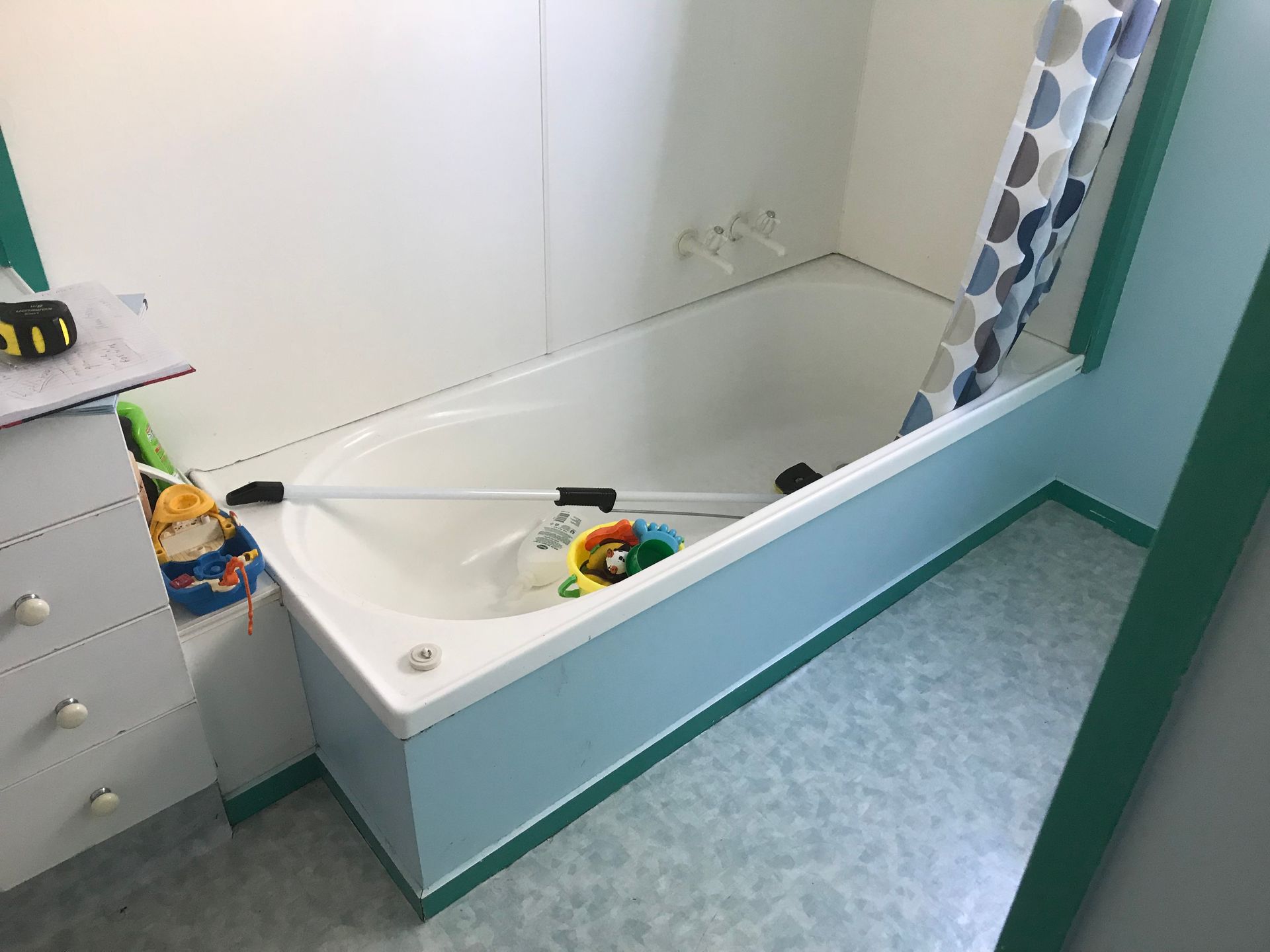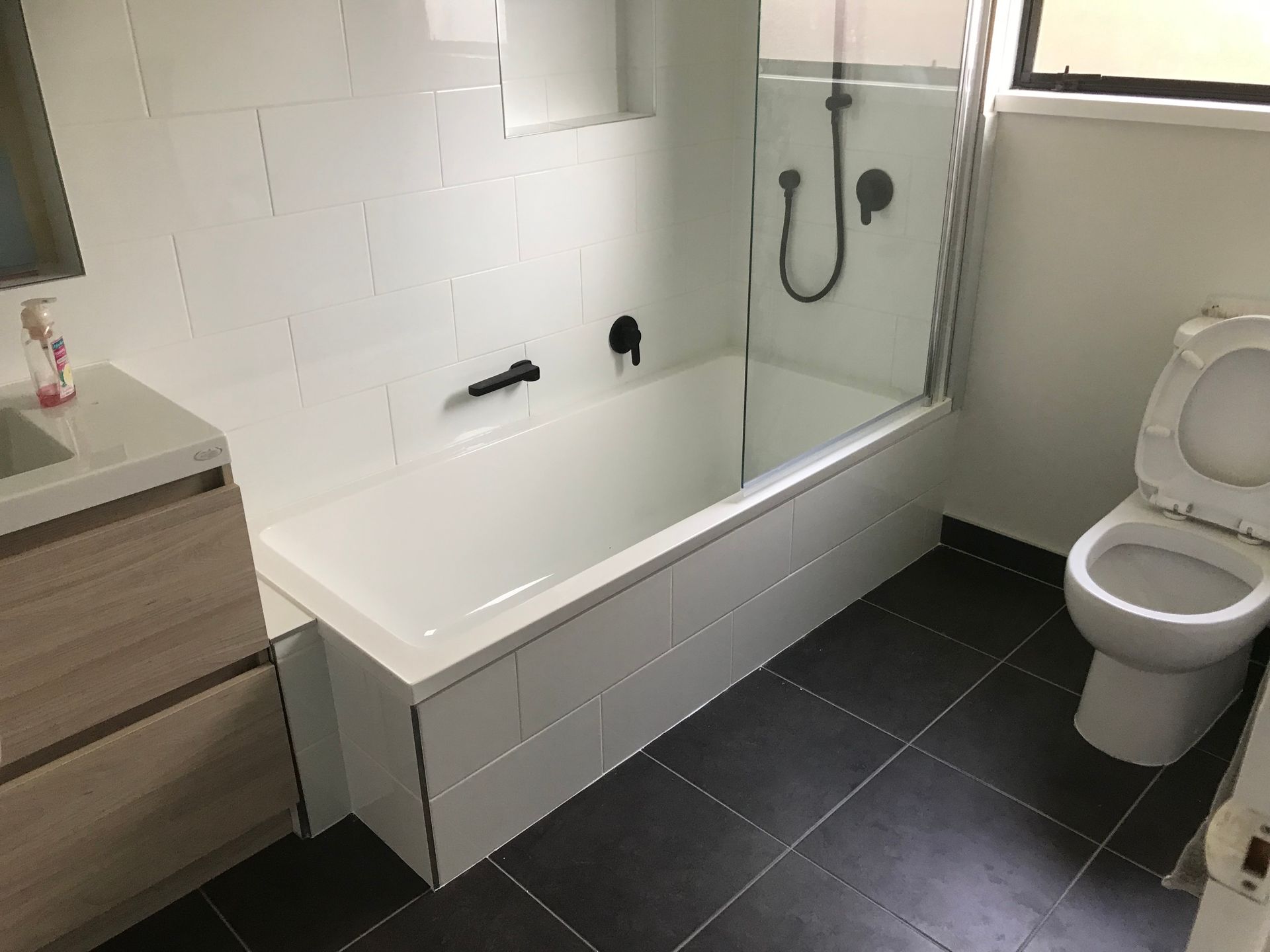Guide to a Successful Bathroom Renovation in 2024
Undertaking a bathroom renovation can be a daunting task. Having to make decisions on designs & materials, sticking to your budget, and all the decisions can be stressful. No need to worry! In this guide, we will cover all you need to know about renovating your bathroom in 2024.
Reasons to renovate your bathroom
The initial reason to remodel your bathroom will be specific to your property and stage of life. You may want to make a small bathroom bigger, separate the toilet, improve accessibility, or update out-of-date décor.
Whatever your initial reason for renovating, consider how you can use this opportunity to improve the space.
Renovating a space to be more desirable to live in
Our bathrooms are a space we are constantly using and spending time in, it should be a place that feels like a sanctuary. Somewhere to prepare for, or unwind from the day and feel good about ourselves.
A lot of bathrooms fail to create this atmosphere, which can be due to layout, materials, fixtures, or a combination of all three. By renovating your bathroom you can start with a clean slate and create a space that works for you practically, and reflects your desired home aesthetic.
Adding Value for a Re-sale
Bathroom renovations are #2 (behind kitchens) for renovations with the highest return on investment when it comes to time to sell. For every dollar you spend on your bathroom you could get $2 back when reselling, and you get to enjoy your new bathroom in the meantime!
To see this increase in value it is crucial that you do not overcapitalize, and instead, make considered and astute choices ensuring your renovation comes in on budget and on trend.
With current market values increasing again in 2024, now could be the ideal time to remodel your bathroom.
Accommodating a larger family
As our families grow and change our homes can struggle to keep up with the demands. Bathrooms are often the battleground where we see these tensions play out.
This can be due to bathrooms that are too small, badly designed, not enough bathrooms, or of course an inadequate hot water supply.
The ideal solution is often to add another bathroom. If you’re playing smart, it’s usually a new ensuite for mum and dad who pay the mortgage!
Using the power of design there is usually a way to remodel your bathroom so that it functions better for the family. Solutions such as separating the toilet and bathroom, swapping out a shower over bath for walk-in shower to create more space, or adding a shower room in another part of the house such as the laundry to make the morning rush a little smoother.
Accessibility or Futureproofing for Retirement
A key driver for renovating or remodeling your bathroom may be to make it more accessible. Perhaps you or a family member is a wheelchair user, has reduced mobility, or perhaps you are planning to retire.
Employing the principles of universal design ensures that you will be comfortable and safe in your home for longer.
What to consider when planning your bathroom renovation
The key to a good bathroom renovation is the right balance of planning and doing. Our experience suggests your project should be 80% planning and 20% doing.
Taking time at the start of the project to consider what your goals are, the best design to achieve them, and finding the right contractor(s) to bring them to life is the important work that underpins any successful renovation.
Space & layout
Whether using the footprint of your existing bathroom, extending it, or creating a new bathroom entirely, you must take time and consult the experts on how to create the optimal layout for your space.
There are many factors to consider such as the location of services, fixtures to include, flow of the space, privacy, lighting, ventilation and storage. It's important to balance all these elements to work in harmony and create a functional space.
Do you need to perform significant building / demolition work?
As a rule of thumb, the more demolition and building work required the more expensive and complex your renovation will be. It also provides the biggest opportunity for change and improvement.
When evaluating your design options, it’s important to discuss what level of demolition and building work you are comfortable with. If it's as little as possible, then you may look to keep the existing layout and simply update the fixtures and some materials.
If your proposed design does require significant building work your contractor will be able to advise you of the necessary consents you will need to acquire before work begins.
Fixtures & fittings
When selecting fixtures and fittings there are three main things to consider:
- performance,
- cost,
- aesthetic value.
There are a wide selection of fixtures available and it can be daunting to know where to start.
We suggest picking a hero piece, something that excites you and reflects your style. Use this as the anchor to then select complimenting pieces that fit the aesthetic and the budget.
Toilet, shower & bath
Every bathroom has at least one of them, and some of them have all three. What the right combination for your bathroom is will depend on your family’s individual needs. In terms of toilets, the question is how many?
One is essential, but two can make a big difference. We strongly recommend a separate toilet room if space allows. This means the toilet and bathroom can be used at the same time.
Bath, shower, or bath over shower will depend on your preference, stage of life, and space available. For some, such as families with young children, a bath is a must-have whilst for others it is the luxury they look forward to at the end of a stressful/busy day.
Showers are also universal to bathrooms nowadays, ranging in size and style to suit your needs. And if you want both but don’t have much space, the shower over bath is your best bet.
Tiling / Paint
Determining the balance of tiled vs painted area in your bathroom will have a big impact on the look and cost of your bathroom. Tile is a part of most bathrooms as flooring. - although not all as variety and quality of vinyl and other alternatives improve.
For your walls, paint is the more affordable option and is also much easier to change in the future. Tile, although certainly more expensive, does provide a permanent and luxurious solution.
Tiles are a popular choice where water is likely to splash on the walls, such as shower walls and behind the vanity. There are also a range of laminated sheets or acrylic liners which provide a cost-effective waterproof solution.


10 Steps to renovate your bathroom in 2024
To make it less daunting, we’ve broken the renovation process down into 10 Steps that will take you from the first seed of an idea to the finished renovation.
1. Plan & design your bathroom renovation
The key to a successful renovation of any kind is 80% planning and 20% doing, so don’t skimp on spending time and consulting experts when planning and designing your bathroom.
If you have trouble understanding or visualizing plan drawings, explore 3D design to ensure your bathroom design looks exactly how you want.
2. Outline a budget and stick to it
Unless you’re a lucky lotto winner, you will likely have a budget to stick to. Do your research and pick a budget that is realistic for the scope of your project.
Ensure that the quote from your local contractor has a clear payment structure and ask questions about any provisional deposits. Understand what the process is for unforeseen circumstances that may impact the result or increase costs.
3. Choose materials, fixtures & fittings
Once you have the layout locked down it is time for the fun part of picking out materials, fixtures, and fittings. This is something where the help of an expert can be worthwhile.
A mood board of inspirational images from Instagram, magazines, or Pinterest, can be a great way to explore and communicate the overall feeling and colour palette you want.
Shop around and take your time to make sure all your selections work together, will perform over time, and fit within your budget.
4. Hire contractors
Finding the right builder/head contractor to complete your bathroom renovation is crucial. We recommend looking for someone with experience and expertise in bathroom renovations.
Be sure to do your research by checking online reviews and asking for examples of past work, as well as testimonials from past customers. These professionals will likely have preferred sub-trades (plumbers, electricians, tilers, etc) that they have worked with before and trust to do quality work at a reasonable price.
Having a lead builder or contractor provide and organize these sub-trades also means your job will run more smoothly and take less time.
5. Apply for Consent (if applicable)
Depending on the extent of your renovation and local council regulations, you may need to request consent from the local council before starting work. Consent is required when additional fixtures are being added, structural changes are being made or waterproofing membranes are being added.
Council consent can take weeks, or even months, so it is essential that you submit your application as early in the process as possible.
6. Begin demolition (if applicable)
Most bathroom renovations will require some demolition. It may be as simple as removing one or two fixtures, or it could involve removing all fixtures as well as flooring, wall, ceiling linings.
Be sure to discuss with your builder what kind of access you will have to your bathroom facilities while renovations are underway and make alternate plans for accommodation if needed.
7. Plumbing & electrical work
With the old removed and your bathroom now a somewhat blank canvas it’s time for the plumbing and electrical sub-contractors to fit off old fixtures and install and prep for new fixtures set to come in.
It is essential that any work requiring licensed trades are undertaken by a qualified tradesperson. This can impact on the longevity of your renovation, as well as your future insurance cover.
8. Painting & tiling
With the in-wall plumbing and electrical work completed it's time for flooring, wall, and ceiling linings to go back up. These are then finished with your chosen paint tile or other wall covering.
In wet room bathrooms, this stage also includes the shaping of the floor, and installation of a waterproofing barrier before applying tiles.
9. Installation of new bathroom fittings
Once your backdrop is ready it is time to place and fit your new fittings and fixtures, this may require several different sub-contractors. This is the stage where your bathroom really comes to life and becomes a functional space.
10. Finishing touches
The finishing touches are what add the polish and pzazz to your bathroom. This could involve adding trim, tidying up the site, and adding décor.
This is also the chance for you and the builder to closely inspect everything to ensure there are no issues, and anything tagged can be resolved. Once this step is completed it's time to pop the bubbly and fill the bath for a celebratory soak in your brand-new bathroom!
Benefits of renovating your bathroom
The benefits of renovating your bathroom are numerous. Your experience is improved daily with a bathroom that better fits the needs and style of your family. Furthermore, when you look at the bigger picture, bathroom renovations typically increase the value of your home (paying for themselves in the long run) and make your home more attractive to potential future buyers.
Improved home value
Simply put the same home with an outdated and badly laid out bathroom is not worth as much as it is with a modern, on-trend, and highly functional bathroom. Studies show that bathroom renovations can have a return on investment as high as 62%.
Improved functionality & usefulness
From a day-to-day point of view, a more functional or additional bathroom makes for more enjoyable individual experiences in the space and better family flow and harmony in the absence of the bathroom line every morning.
Benefits could be more practical such as instances where accessibility is a key motivation - a bathroom renovation could bring a significant improvement in independence and quality of life.
Bathroom renovation FAQs
If you're thinking of renovating, there are usually some common questions that pop up. People want to understand what kind of cost is involved. Will the project need building consent? How long will it take? We answer all of these and more below.
-
Do I need consent to renovate a bathroom in New Zealand?
No consents are required for bathroom renovations that are "like for like" and don't include additional fixtures or waterproofing under tiles.
Conversely building consent is required when additional fixtures are being added, structural changes are being made or waterproofing membranes are being added.
-
How difficult is it to remodel a bathroom yourself?
Because of the specialized skills involved in a bathroom renovation such as plumbing, electrical, waterproofing, and tiling work, we don’t recommend applying the Kiwi DIY attitude to your bathroom remodel. Further to this, a lot of the work involved must be carried out by a licensed practitioner to be considered safe and in compliance with the NZ Building Code.
-
How long should a bathroom remodel take?
A typical bathroom renovation will take between 5 and 15 weekdays, or 3 weeks, of onsite work based on being on the same footprint. If extensive tiling is required, this will take 3 days as will plastering and painting.
Additional building work creating a new bathroom footprint would likely be additional.
If consent is required, this will take 2-5 weeks to go through the council based on the extent of the changes.
Need help planning your Bathroom Renovation?
Talk to our friendly team across New Zealand
List of services
-
NorthlandItem link List Item 1
Whakapara
Whangarei
Marsden Point
Ruakaka
Waipu
Maungatapere
Mangawhai
-
North ShoreItem link List Item 2
Wellsford
Warkworth
Puhoi
Silverdale
Albany
Glenfield
Takapuna
Northcote
Birkenhead
-
AucklandItem link List Item 3
Ponsonby
Point Chevalier
Mount Albert
Avondale
New Lynn
Mount Roskill
Parnell
Mt Eden
New Market
Remuera
St Helliers
Ellerslie
-
ManawatuItem link List Item 4
Marton
Bulls
Feilding
Palmerston North
Ashurst
Woodville
Foxton
Shannon
Levin
-
Kapiti CoastItem Link
Otaki
Kapiti Coast
Te Horo
Peka Peka
Paraparaumu
Paekakariki
-
WellingtonItem Link
Porirua
Johnsonville
Newlands
Khandallah
Ngaio
Wadestown
List of services
-
WaikatoItem link List Item 1
Hamilton
Rukuhia
Te Awamutu
Cambridge
Karipiro
Matamata
-
Bay of PlentyItem link List Item 2
Omokoroa
Te Puna
Mount Maunganui
Tauranga
Papamoa
Te Puke
Pyes Pa
-
TaranakiItem link List Item 3
Waitara
Bell Block
New Plymouth
Fitzroy
Strandon
Merrilands
Welbourne
Westown
Oakura
Egmont Village
Inglewood
-
Hutt ValleyItem link List Item 4
Petone
Lower Hutt
Eastbourne
Wainuiomata
Stokes Valley
Silverstream
Heretaunga
Upper Hutt
Totara Park
-
NelsonItem Link
Wakapuaka
Nelson
Tahunanui
Stoke
Richmond
Brightwater
Wakefield
Mapua
-
ChristchurchItem Link
Kaiapoi
Belfast
Papanui
Merivale
Fendalton
Halswell
Riccarton
Addington
Woolston
See below to download your free informative e-books and subscribe to our monthly informative and thought provoking ezine
Subscribe to our Come Alive! Newsletter
It's FREE and comes to you via email every month providing informative articles, tips and ideas!
Newsletter Form
We will get back to you as soon as possible.
Please try again later.
Visit our FREE E - Library
Have you thought about renovating but don't know where to start?Browse and download a variety of E-Books and other resources that cover tips and tricks, latest trends and breakdown the renovation process.
What we do:
Back to:


